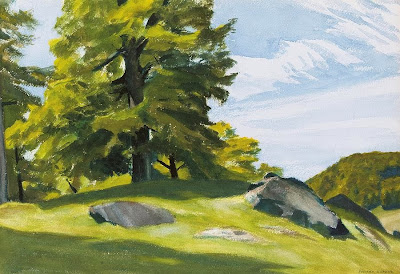Philip Koch Work in Studio Visit Magazine

Above is the two-page spread on my paintings that appears in the new Volume 24 of Studio Visit magazine. Given that these two of my favorite paintings are reaching a broader audience I thought it would be good to tell a little more about them. In this post I'll take up the first one. Inland , oil on canvas, 45 x 60", 2008 at George Billis Gallery, New York The forests of inland New England are really dense. So much so that I often resort to searching out the clearing provided by a beaver pond so I can see more of a vista. In the early days of American landscape painting small farms dotted New England. Painters of the Hudson River School like Cole and Church could set up their easels anywhere and likely find a panoramic view without too much trouble. That all changed with the expansion of mechanized agriculture in the Midwest. New England's rocky soil and hilly sloping fields made the going harder. A lot of New England farms failed and their...




.jpg)
